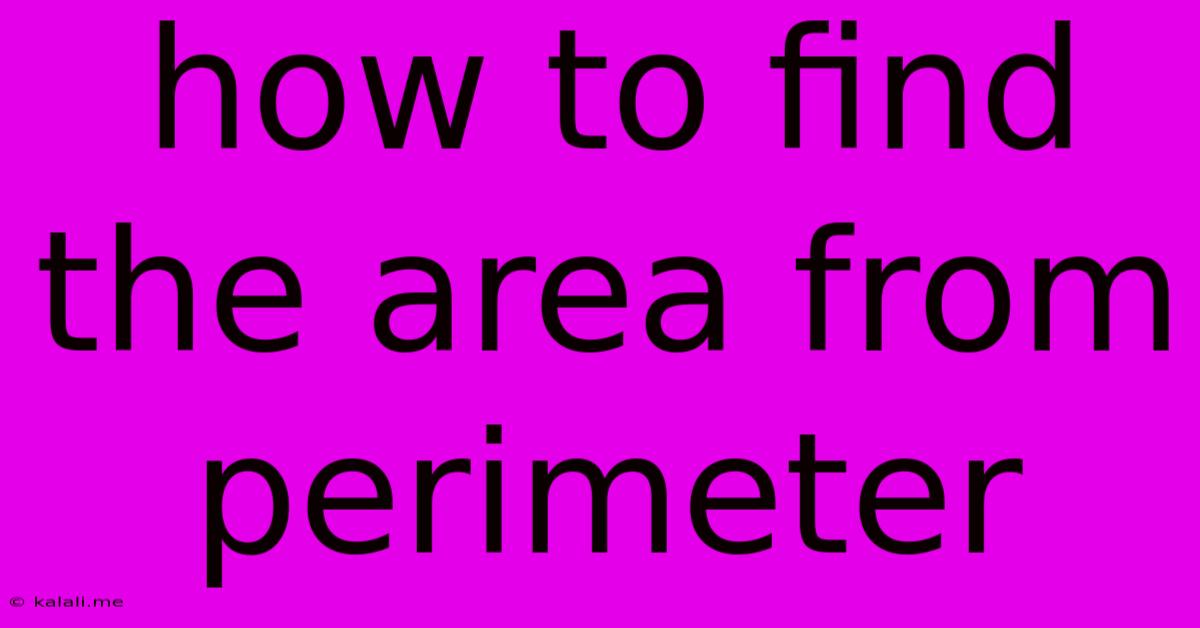How To Find The Area From Perimeter
Kalali
May 23, 2025 · 3 min read

Table of Contents
How to Find the Area from Perimeter: A Guide for Different Shapes
Knowing the perimeter of a shape doesn't automatically tell you its area. Perimeter measures the distance around a shape, while area measures the space inside the shape. However, for certain regular shapes, you can find the area if you know the perimeter. This article will guide you through calculating area from perimeter for various common shapes. Remember, this is only possible with specific shapes and requires additional information or assumptions in most cases.
Understanding the Difference: Perimeter vs. Area
Before diving into the calculations, it's crucial to understand the difference between perimeter and area:
- Perimeter: The total distance around the outside of a shape. Think of it as walking around the edges; the total distance you walk is the perimeter.
- Area: The amount of space enclosed within a shape. Think of it as the space you could cover with paint; the total space you cover is the area.
Calculating Area from Perimeter: Specific Cases
Let's explore how to find the area given the perimeter for some regular shapes. Note: For irregular shapes, it's generally impossible to determine the area from the perimeter alone.
1. Square
A square has four equal sides. Let 's' represent the length of one side.
- Perimeter (P): P = 4s
- Area (A): A = s²
To find the area from the perimeter:
- Solve for 's': s = P/4
- Substitute 's' into the area formula: A = (P/4)² = P²/16
Example: If the perimeter of a square is 20 cm, then s = 20/4 = 5 cm. The area is 5² = 25 cm².
2. Rectangle
A rectangle has two pairs of equal sides. Let 'l' and 'w' represent the length and width respectively.
- Perimeter (P): P = 2(l + w)
- Area (A): A = l * w
Determining the area from the perimeter alone is impossible for a rectangle because you need to know the ratio between length and width. You need at least one additional piece of information, such as the length or width, or the ratio between the length and width.
3. Circle
A circle has a radius (r) and a diameter (d = 2r).
- Perimeter (Circumference, C): C = 2πr
- Area (A): A = πr²
To find the area from the circumference:
- Solve for 'r': r = C/(2π)
- Substitute 'r' into the area formula: A = π * (C/(2π))² = C²/(4π)
Example: If the circumference of a circle is 10 cm, then r = 10/(2π) cm. The area is π * (10/(2π))² ≈ 7.96 cm².
4. Equilateral Triangle
An equilateral triangle has three equal sides. Let 's' represent the length of one side.
- Perimeter (P): P = 3s
- Area (A): A = (√3/4)s²
To find the area from the perimeter:
- Solve for 's': s = P/3
- Substitute 's' into the area formula: A = (√3/4)(P/3)² = (√3/36)P²
Example: If the perimeter of an equilateral triangle is 12cm, then s = 12/3 = 4cm. The area is (√3/4)*4² ≈ 6.93 cm².
Conclusion:
Finding the area from the perimeter is possible for certain regular shapes like squares and circles. However, for rectangles and most other shapes, additional information is required to calculate the area. Remember to always understand the properties of the shape you're working with to choose the appropriate formula and ensure you have the necessary data.
Latest Posts
Latest Posts
-
Same Role Internship Vs Full Time Resume
May 23, 2025
-
When Does Lhopitals Rule Not Apply
May 23, 2025
-
Lock Is Too High For Doorhole
May 23, 2025
-
What Size Wire For 100 Amp Subpanel
May 23, 2025
-
Error Mounting Dev Sdb1 At Media Wrong Fs Type
May 23, 2025
Related Post
Thank you for visiting our website which covers about How To Find The Area From Perimeter . We hope the information provided has been useful to you. Feel free to contact us if you have any questions or need further assistance. See you next time and don't miss to bookmark.